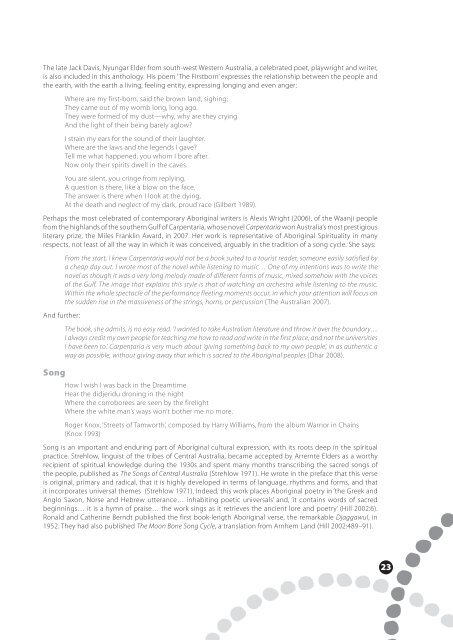DP9-Aboriginal-Spirituality
DP9-Aboriginal-Spirituality
DP9-Aboriginal-Spirituality
Create successful ePaper yourself
Turn your PDF publications into a flip-book with our unique Google optimized e-Paper software.
The late Jack Davis, Nyungar Elder from south-west Western Australia, a celebrated poet, playwright and writer,<br />
is also included in this anthology. His poem ‘The Firstborn’ expresses the relationship between the people and<br />
the earth, with the earth a living, feeling entity, expressing longing and even anger:<br />
Where are my first-born, said the brown land, sighing;<br />
They came out of my womb long, long ago.<br />
They were formed of my dust—why, why are they crying<br />
And the light of their being barely aglow<br />
I strain my ears for the sound of their laughter.<br />
Where are the laws and the legends I gave<br />
Tell me what happened, you whom I bore after.<br />
Now only their spirits dwell in the caves.<br />
You are silent, you cringe from replying.<br />
A question is there, like a blow on the face.<br />
The answer is there when I look at the dying,<br />
At the death and neglect of my dark, proud race (Gilbert 1989).<br />
Perhaps the most celebrated of contemporary <strong>Aboriginal</strong> writers is Alexis Wright (2006), of the Waanji people<br />
from the highlands of the southern Gulf of Carpentaria, whose novel Carpentaria won Australia’s most prestigious<br />
literary prize, the Miles Franklin Award, in 2007. Her work is representative of <strong>Aboriginal</strong> <strong>Spirituality</strong> in many<br />
respects, not least of all the way in which it was conceived, arguably in the tradition of a song cycle. She says:<br />
And further:<br />
Song<br />
From the start, I knew Carpentaria would not be a book suited to a tourist reader, someone easily satisfied by<br />
a cheap day out. I wrote most of the novel while listening to music… One of my intentions was to write the<br />
novel as though it was a very long melody made of different forms of music, mixed somehow with the voices<br />
of the Gulf. The image that explains this style is that of watching an orchestra while listening to the music.<br />
Within the whole spectacle of the performance fleeting moments occur, in which your attention will focus on<br />
the sudden rise in the massiveness of the strings, horns, or percussion (The Australian 2007).<br />
The book, she admits, is no easy read. ‘I wanted to take Australian literature and throw it over the boundary…<br />
I always credit my own people for teaching me how to read and write in the first place, and not the universities<br />
I have been to.’ Carpentaria is very much about ‘giving something back to my own people’, in as authentic a<br />
way as possible, without giving away that which is sacred to the <strong>Aboriginal</strong> peoples (Dhar 2008).<br />
How I wish I was back in the Dreamtime<br />
Hear the didjeridu droning in the night<br />
Where the corroborees are seen by the firelight<br />
Where the white man’s ways won’t bother me no more.<br />
Roger Knox, ‘Streets of Tamworth’, composed by Harry Williams, from the album Warrior in Chains<br />
(Knox 1993)<br />
Song is an important and enduring part of <strong>Aboriginal</strong> cultural expression, with its roots deep in the spiritual<br />
practice. Strehlow, linguist of the tribes of Central Australia, became accepted by Arrernte Elders as a worthy<br />
recipient of spiritual knowledge during the 1930s and spent many months transcribing the sacred songs of<br />
the people, published as The Songs of Central Australia (Strehlow 1971). He wrote in the preface that this verse<br />
is original, primary and radical, that it is highly developed in terms of language, rhythms and forms, and that<br />
it incorporates universal themes (Strehlow 1971). Indeed, this work places <strong>Aboriginal</strong> poetry in ‘the Greek and<br />
Anglo Saxon, Norse and Hebrew utterance… inhabiting poetic universals’ and, ‘it contains words of sacred<br />
beginnings… it is a hymn of praise… the work sings as it retrieves the ancient lore and poetry’ (Hill 2002:6).<br />
Ronald and Catherine Berndt published the first book-length <strong>Aboriginal</strong> verse, the remarkable Djaggawul, in<br />
1952. They had also published The Moon Bone Song Cycle, a translation from Arnhem Land (Hill 2002:489–91).<br />
23


